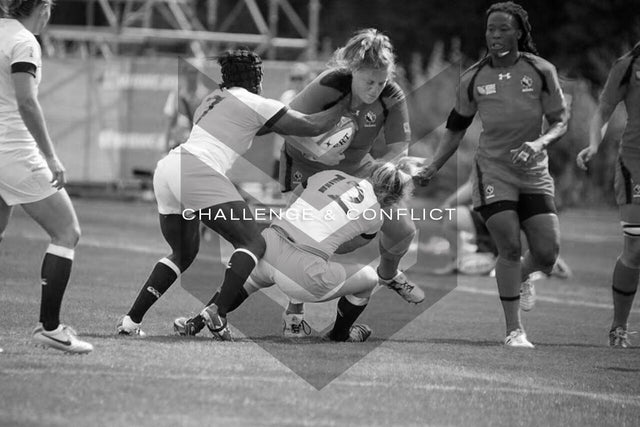Team Dynamics and Group Process: Challenge and Conflict
Written By: Andrea Burk
Photo Credit: Ron Leblanc
We all saw it. Canada's Olympic gold medal dreams vanished as they fell 17-5 to Australia – the eventual Olympic Champions – in the semi-finals at the Summer Games 2016 in Rio de Janeiro. In rugby sevens, there isn’t a lot of time to turn around from a loss. Canada had about an hour and a half to prepare for the bronze medal match and everyone was hurting.
What does it take to move through a challenging place and come out on top?
Olympic bronze medalist and 2017 World Rugby Women’s 7s player of the year nominee Ghislaine Landry, and Canadian international prop and scrum coach Gary Dukelow, both agree it comes down to communication. Dukelow says “constant and open communication should be the norm. Be a warrior, not a worrier – too much drama can kill a team’s culture.”
At the Olympics, the eventual bronze medallists did exactly that. They acknowledged and named the reality of the situation by putting it into perspective. Landry recalls: “we were quiet, a few of us were in tears...the room was heavy.” More than four years of work had gone in 14 minutes. “We named and called it for exactly what it was. It hurt, it was a disappointing place to be, but we still had a chance to do something great. There was still a medal on the line. Over the next hour everyone got themselves to a place where they could perform; where we could play the best game we could play.” And so they did, hammering Great Britain 33-10 for the bronze medal in arguably Canada’s best game of the tournament.
Landry recommends having the conversations that people are scared to have. For her and her teammates, conflict arises. They spend every day together, so “it is important talk to the right people. Not the person who will tell you what you want to hear or the ten people who don’t have any answers. Go to the person that has the answers; even if you are hesitant. If you are scared or anxious to have the conversation, that’s a sign that it needs to be had.”
What can be expected from players and other group members?
Challenge shows up in many ways and in many places. It might be in the middle of a game, a practice, in the middle of a training phase or a workout, or in the middle of a season or quadrennial. It can be between two people, groups of people, or completely internal. The process of moving through challenge and conflict remains relatively the same, even if the landscape is different.
Challenge and conflict arises from an emotional response to the task at hand. It is marked by an inner or outer struggle and can be identified with anger directed at self or others, and often coaches. It might also look like disengaging or minimizing the importance of the task or goals.
What are key Challenge Phase and group structure indicators?
Two major developmental characteristics (or indicators) are present in each phase. These are: the group’s purpose and responsibilities, and the socio-emotional stage.
The 'Challenge Phase' is marked by the emotional response to task demands and conflict within the group.
While all phases are important for different reasons, the Challenge Phase is particularly important, because how the group moves through this phase strongly affects the group’s commitment, involvement and production later on.
Leadership during conflict: What does the group (players, staff, volunteers and supporters) need? How can they be motivated?
Group members need a clear sense of what is going on and the commitment they made to do it together. This might also ask for a reminder of the fundamental purpose of their being here, which was addressed in the beginning phase.
The best way to get through this phase as a cohesive unit is to acknowledge it and have (or encourage) the difficult conversations. Taking this action builds trust, confidence and resilience when done with openness and care for all.
Common challenges?
It is safe to say that the “Honeymoon Phase” is over. The hopeful optimistic will either be sad, in disbelief, or remain clinging to hope, saying “its going to get better…it has to!” The grounded analytic-types – while likely thinking “I told you so” – will also be asking: “what’s our next step?”
No one approach is the best approach, the ideal is a blend of the two. It’s the mind that recognizes the challenge, takes it head on and says, “This is going to make us better” and “we are going to get through this, and we are going to get through it together!”
As a coach, and a leader, it is important to remind the team of this approach while watching for unresolved conflict and difficult subjects or relationships that are being avoided. This has also been referred to as 'false harmony', where everything is ‘fine’.
Less evolved groups might need more direction and decisive leadership, but give them time to sort it out. The best strength, confidence and resilience is built when teams work through it together, rather than being rescued. Its like training and strengthening a muscle at the gym; the more you stress it, the stronger it gets; At the same time, the muscle needs to be cared for in order to be as strong as possible, and this is where the group process work comes in.
Leadership will be tempted to lower benchmarks, or goals, so they seem more attainable and can decrease the perceived ‘pain’ (physical, emotional, etc). Rather than changing the goal, work with the team to break it down into more manageable milestones, or devise a plan as to how to manage the stress (physical, emotional, interpersonal, etc). They will be thankful they did!
How can leadership styles be adapted to meet the groups needs in pursuit of performance?
Name it. Acknowledge it. Don’t avoid any hard subjects. Acknowledge reality and remind them of the resources they have available to them and within them. Facilitate resolution, don’t hand it to them. Set up the group to rely on each other to get through to build confidence and resilience. Be the leader that says, “This isn’t easy AND we can do this!”
Acknowledge the human process and what's going on and what is to come in each stage. This will help people to emotionally cope with what is going on and prepare for what is to come, allowing for better production and overall on-field performance.
Next Week: The Resolution Phase (phew!)
Source: Dimock, H. G., & Kass, R. (2007). How to observe your group. (4th ed.). Concord, ON: Captus Press.


